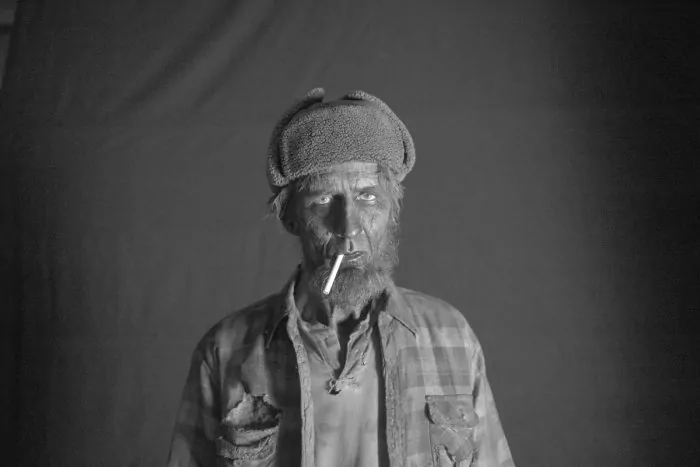Gotta light?
Maybe it’s Twin Peaks (says writer Mark Frost). Or maybe it’s not (says Eraserhead director David Lynch).
Or maybe it’s really just House Hunters International on acid, shot in black and white and with above average sound design.
However you describe Twin Peaks: The Return (aka Season 3), and specifically last night’s groundbreaking episode 8 (origin story, good vs. evil), you have to admit: David Lynch has done it again. In a world of infinite content, and infinite choice, the auteur has proven without a doubt that when it comes to surrealism he’s absolutely the best we’ve ever seen. And, amazingly, where others before him at this phase of their careers have thrown in the towel or lost their creative edge, Lynch continues to operate at such an exceptional artistic level that it defies logic… and as we saw, again, in Twin Peaks The Return, it often results in something so achingly beautiful that it too defies logic.

There’s no rational way to review this reboot of Twin Peaks. It’s more fun to let it wash over you. And then head over to Twitter and chuckle with Lynchian glee when fans wonder when they will finally — finally! — get to see their lovely Audrey Horne.
To this viewer the new show is marvelous in every way possible. More of a fan of his film then his TV work (I didn’t watch the original series until this year to ready for his return), I see it as the gift that keeps on giving. I mean, 18 hours! Of David Lynch! (and co-writer Mark Frost). Giving us wildly quirky rides without any constraints! This is Showtime. Not ABC. Thankfully. That these guys have slightly more bargaining power than they did in 1992 is immediately evident.
Reviews seem to be overwhelmingly positive. Esquire said part 8 “will be remembered as one of the best episodes of television ever.”
A quick scan of Twitter, however, will reveal many — perhaps more enamored with Twin Peaks than David Lynch himself — thought it veered to far into the ether. Bring back Audrey they cried. And normal soap-style narrative, seems to sum up much of the dissent.
Part 8 was heavily hyped. That it would fall on a Sunday before a two week break (for Independence Day) gives the press, fans, and social media a large window of time to mull over the proceedings. A strategic move to be sure. So far that seems to be working quite well (#TwinPeaks was even trending on Twitter after it was released yesterday on Showtime) and it certainly makes us wonder what on earth (or space) is coming next.
The official Twin Peaks Twitter handle operated by Showtime, and others associated with the production (like director of photography Peter Deming), promised that part 8 would be “like no other.” Right, what marketer hasn’t ever said that before? Given the topsy-turvy nature of the series so far, veering from off-the-wall Lynchian surrealism one moment to dabbling in the soapy storylines that the original trafficked in, perhaps the same could be same for all seven parts that preceded last night’s “Gotta light?”.
I’m not sure how to describe what happened (it’s an experience, man). But I’m guessing film schools across the country are updating their syllabi and making part 8 mandatory viewing for students. (Tip: watch it with the lights out, and the biggest screen you can find with a good speaker setup.)
We all knew this isn't really #TwinPeaks. It's 18hr David Lynch masterclass. That sound? Film schools updating syllabus: ep 8 mandatory. pic.twitter.com/AL9Ddn0lvp
— Clinton Stark (@clintonstark) June 26, 2017
It will go down in history. I can already see the art installation known as episode 8 playing in museums across Paris. #TwinPeaks
— Clinton Stark (@clintonstark) June 26, 2017
After 2nd viewing felt like lost episode of House Hunters International with above average sound design. #TwinPeaks
— Clinton Stark (@clintonstark) June 26, 2017
I loved every second of it, all 58:17 to be precise.
Partly because it’s Lynch being Lynch. Traditional structures associated with episodic TV are thrown out the window. Same with what viewers have come to expect from plot, sound, and editing. There’s narrative alright. It’s just not spoon fed to us. I suspect those that appreciated the charming small town of Twin Peaks and Audrey Horne’s interest in agent Dale Cooper, and the day-to-day demurs of Bobby and Shelly, and love-ability of Lucy and Andy, and the scheming of Josi, and mad ravings of Leland Palmer, are likely not too keen on where season 3 has thus far taken all their favorite characters.
Meanwhile, I’m guessing art-house dwellers and fans of Lynch’s short films and works like Mulholland Drive, Lost Highway, Blue Velvet and Eraserhead are lapping this stuff up. If you’re like me, maybe even slightly guilty that it means the world of Twin Peaks is being blown up (in slow motion) and put through a purgatory as stylized by Francis Bacon, Fellini and Billy Wilder.

Then again, we pretty much knew this was never really “Twin Peaks.”
I see it as a magnificent swan song by one of cinema’s best. And when a great artist is doing his thing, you just stand back in awe, and be glad to be alive to bear witness to a master at work, without corporate restraints. Complete creative freedom. Television history — once again. As The New York Times puts it, “this episode is just director David Lynch — one of cinema’s true adventurers — emptying out his subconscious, unabated.”
Clint Stark on Twin Peaks & David Lynch
Would it be surprising to see an art installation featuring part 8 somewhere in a museum in Paris?
Not in the least.
What a career. (!)

